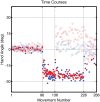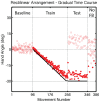Context-dependent generalization
- PMID: 23653603
- PMCID: PMC3644715
- DOI: 10.3389/fnhum.2013.00171
Context-dependent generalization
Abstract
The pattern of generalization following motor learning can provide a probe on the neural mechanisms underlying learning. For example, the breadth of generalization to untrained regions of space after visuomotor adaptation to targets in a restricted region of space has been attributed to the directional tuning properties of neurons in the motor system. Building on this idea, the effect of different types of perturbations on generalization (e.g., rotation vs. visual translation) have been attributed to the selection of differentially tuned populations. Overlooked in this discussion is consideration of how the context of the training environment may constrain generalization. Here, we explore the role of context by having participants learn a visuomotor rotation or a translational shift in two different contexts, one in which the array of targets were presented in a circular arrangement and the other in which they were presented in a rectilinear arrangement. The perturbation and environments were either consistent (e.g., rotation with circular arrangement) or inconsistent (e.g., rotation with rectilinear arrangement). The pattern of generalization across the workspace was much more dependent on the context of the environment than on the perturbation, with broad generalization for the rectilinear arrangement for both types of perturbations. Moreover, the generalization pattern for this context was evident, even when the perturbation was introduced in a gradual manner, precluding the use of an explicit strategy. We describe how current models of generalization might be modified to incorporate these results, building on the idea that context provides a strong bias for how the motor system infers the nature of the visuomotor perturbation and, in turn, how this information influences the pattern of generalization.
Keywords: generalization (psychology); models; motor adaptation; motor control; motor learning; theoretical.
Figures










Similar articles
-
Adaptation and spatial generalization to a triaxial visuomotor perturbation in a virtual reality environment.Exp Brain Res. 2019 Mar;237(3):793-803. doi: 10.1007/s00221-018-05462-2. Epub 2019 Jan 3. Exp Brain Res. 2019. PMID: 30607472
-
Impaired visuomotor generalization by inconsistent attentional contexts.J Neurophysiol. 2017 Sep 1;118(3):1709-1719. doi: 10.1152/jn.00089.2017. Epub 2017 Jun 28. J Neurophysiol. 2017. PMID: 28659458 Free PMC article.
-
Plan-based generalization shapes local implicit adaptation to opposing visuomotor transformations.J Neurophysiol. 2018 Dec 1;120(6):2775-2787. doi: 10.1152/jn.00451.2018. Epub 2018 Sep 19. J Neurophysiol. 2018. PMID: 30230987 Free PMC article.
-
Attention modulates generalization of visuomotor adaptation.J Vis. 2013 Oct 16;13(12):12. doi: 10.1167/13.12.12. J Vis. 2013. PMID: 24133292
-
Do prism and other adaptation paradigms really measure the same processes?Cortex. 2019 Oct;119:480-496. doi: 10.1016/j.cortex.2019.07.012. Epub 2019 Aug 10. Cortex. 2019. PMID: 31525564 Review.
Cited by
-
Aging Effect on Visuomotor Adaptation: Mediated by Cognitive Decline.Front Aging Neurosci. 2021 Oct 28;13:742928. doi: 10.3389/fnagi.2021.742928. eCollection 2021. Front Aging Neurosci. 2021. PMID: 34776929 Free PMC article.
-
Introduction to the special topic: a multidisciplinary approach to motor learning and sensorimotor adaptation.Front Hum Neurosci. 2013 Sep 9;7:543. doi: 10.3389/fnhum.2013.00543. eCollection 2013. Front Hum Neurosci. 2013. PMID: 24058338 Free PMC article. No abstract available.
-
Motor adaptation and generalization of reaching movements using motor primitives based on spatial coordinates.J Neurophysiol. 2015 Feb 15;113(4):1217-33. doi: 10.1152/jn.00002.2014. Epub 2014 Nov 26. J Neurophysiol. 2015. PMID: 25429111 Free PMC article.
-
Vowel generalization and its relation to adaptation during perturbations of auditory feedback.J Neurophysiol. 2017 Nov 1;118(5):2925-2934. doi: 10.1152/jn.00702.2016. Epub 2017 Aug 23. J Neurophysiol. 2017. PMID: 28835529 Free PMC article.
-
Adaptation and spatial generalization to a triaxial visuomotor perturbation in a virtual reality environment.Exp Brain Res. 2019 Mar;237(3):793-803. doi: 10.1007/s00221-018-05462-2. Epub 2019 Jan 3. Exp Brain Res. 2019. PMID: 30607472
References
-
- Conditt M. A., Gandolfo F., Mussa-Ivaldi F. A. (1997). The motor system does not learn the dynamics of the arm by rote memorization of past experience. J. Neurophysiol. 78, 554–560 - PubMed
Grants and funding
LinkOut - more resources
Full Text Sources
Other Literature Sources

